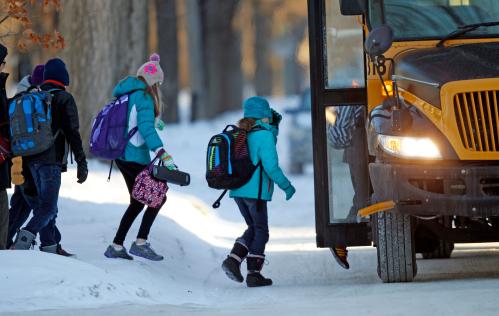Nearly everyone would agree that every child should have access to a high-quality education, yet there is little consensus for how to make this a reality. Many education reformers believe school choice can help. School choice, broadly defined, proposes that parents can choose to send their children to school wherever they think best, and not simply the nearest school as has been typically done in the U.S. In theory, school choice can help improve access to quality schools and the educational prospects for our most disadvantaged children.
In recent years, the U.S. Department of Education has pushed for significant expansion of school choice programs. In 2017, for example, the federal administration proposed a budget dedicating $1.4 billion to expanding school choice vouchers, a proposal that Congress rejected. Last month, Secretary of Education Betsy DeVos proposed a new federal tax credit for individuals and companies that make donations to scholarships that enable students to attend education programs outside of traditional public schools. Data suggests that most Americans are on board with the expansion of school choice programs. In a recent poll, for example, 54 percent of respondents said they favored universal school choice policies. The rise in charter school enrollments also demonstrates the demand for school choice. Between 2016 and 2017, charter school enrollments increased by 5 percent to 3.2 million students.
In light of the national discourse, it is important to critically assess the arguments both for and against school choice proposals, and the rigorous evidence behind them.
In a recent, randomized controlled trial study, we assessed a common critique of school choice—that when given the option, schools discriminate against students who are perceived as harder to educate, therefore restricting certain students to lower-quality schools and consequently exacerbating educational disparities.
To minimize the extent to which schools can cherry-pick top students, many school choice districts must use a lottery system or a common application to determine who is admitted. Despite these safeguards, schools can employ subtle practices to recruit the students they would prefer, for example by encouraging or discouraging applications from certain types of students.
In particular, schools can exploit the lack of knowledge that many parents and students face when deciding which schools to attend, including information on school quality, student eligibility, and the admissions process.
To test whether this was happening, we sent emails posing as parents of potential students to schools. In each email, the fictitious parent asked whether his or her child was eligible to apply to the school and how to apply. In total, we sent emails to 6,452 schools (both charters and traditional public schools) from the largest 40 school districts in 29 states and the District of Columbia, all of which have intra-district school choice. We sent two different emails to each school three to four weeks apart, and no school received the same message twice.
We randomly assigned each email to signal a different student characteristic, such as a potentially restrictive special need, poor behavior, or high or low prior academic achievement. The emails that signaled a restrictive special need stated that the student had an individualized education plan (IEP), which requires that the student be taught in a classroom separate from mainstream students. We also randomly assigned some emails to have no signaled characteristics. Across all emails, we also randomly varied the implied race, household structure, and gender of the student. By leveraging random assignment, we could measure whether schools changed their likelihood of response based on certain student characteristics.
We found that, on average, both charter and traditional public schools were less likely to respond to emails from parents of students whom schools may perceive as harder or costlier to educate. Schools that received standard emails with no signaling characteristics responded 53 percent of the time. Compared to this figure, schools were 5 percentage points less likely to respond if the email mentioned an IEP, 7 percentage points less likely to respond if the email mentioned poor behavior, and 2 percentage points less likely to respond if the email mentioned low prior academic achievement. However, we found no difference in response rates if the email mentioned good prior academic achievement and attendance.
Overall, there were similar response rates across charter schools and traditional public schools. However, charter schools were 6 percentage points less likely than traditional public schools to respond to emails from parents of a child with an IEP. In particular, we identified 272 “no-excuses” charter schools, which tend to be higher performing, in the sample. These schools were 10 percentage points less likely to respond to messages signaling an IEP than traditional public schools.
These findings suggest that schools in school choice districts may be selectively discouraging certain groups of students from applying. By withholding information from certain types of students, particularly those who may seem more difficult to educate, schools may be contributing to a key source of educational inequality.
Some policies may hold promise in mitigating these impacts, however. For example, Michigan and Wisconsin provide partial or full reimbursements to districts to offset the additional costs of serving special-needs students, who cost on average 2.3 to 2.5 times the average cost of a child without special needs. When we assess the response rates of charter schools in these states, we find that schools respond at equal rates to emails that signal an IEP and emails that do not. This suggests that policies that reimburse schools for their special education costs may eliminate schools’ incentive to discourage applications from students with an IEP.
Moreover, regular audits of schools’ responsiveness to parents could be an effective way to monitor and deter efforts to selectively discourage or encourage certain students to apply. Several education agencies in the United States already employ audits similar to our study to monitor whether schools are providing information equitably across families.
The results also highlight the importance of understanding more about how schools in school choice districts may selectively favor some students over others. For example, we still know very little about how schools may respond to students with specific learning disabilities or limited English proficiency. As conversations around school choice continue, it is important that we consider the distributional consequences that may arise from school choice policies, and rigorously monitor and evaluate how schools may discriminate against particular students.
Amid the partisan debate over education reform, education policymakers should strongly consider the empirical evidence on how school choice policies may or may not exacerbate disparities in educational access and outcomes. By focusing on solutions grounded in evidence, we may get one step closer to helping all children get the high-quality education they deserve.
The Brookings Institution is committed to quality, independence, and impact.
We are supported by a diverse array of funders. In line with our values and policies, each Brookings publication represents the sole views of its author(s).







